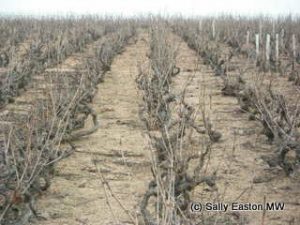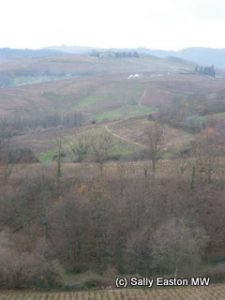Jean-Marc Burgaud

Beaujolais cru
Jean-Marc Burgaud started in 1989, the same year he married his wife, Christine. Both sets of parents were winegrowers, so there was clearly something in the blood. They have built up their vineyards to 19 hectares: 13 ha in Morgon, 5 ha in Beaujolais Villages and 1 ha in Régnié, which is “the maximum for me” Jean-Marc said, adding, while “it’s always possible to grow bigger, it’s important to stay precise” and it’s that attention to detail that is reflected in his wines.
In the vineyard Jean-Marc works traditionally, ploughing the soil. He’s not certified organic, but his philosophy is both traditional and manual. He hasn’t used chemical insecticide for 10 years, and only once in that time has he been forced by the vintage to resort to using a non-organic product in the vineyard.
The traditional high vine density of 10, 000 bush vines per ha is an important feature for quality, said Burgaud “it is important for gamay to have competition in the soil so you get little grapes with concentration.” There has been a trend in Beaujolais to reduce planting densities to around 5,000 vines / ha, but, he said “the yield per vine goes up, so you have the fruit, but not the complexity and concentration.”
Vinification is by traditional semi-carbonic maceration, the same method for all his wines, though the length of maceration varies – seven days for the Beaujolais Villages and up to 15 days for his best Morgon parcels in the Côte du Py.
Grapes are put into his cement tanks and the temperature controlled to between 22 and 24°C. The bunches have been pre-sorted in the vineyard “so we never have perfect bunches and bad bunches in the same box.”

Rolling Beaujolais hills
He takes some of the juice from the bottom of the vat, squeezed by the weight of grapes above, and sprays it over the top of the vat to oxygenate this small amount of juice for the natural yeasts to kick off the fermentation. To keep the mass of grape bunches moist during maceration he pumps over the juice daily, now without oxygen. He said the grapes “need humidity to have a good fermentation inside the berries.”
A quarter of the harvest from Burgaud’s Côte du Py vineyards finishes off the fermentation in barrel, otherwise he’s using only cement, which helps retain the juicy fruits and floral perfumes of gamay.
Burgaud has made a Côte du Py reserve since 1995. He explained “Reserve has no legal meaning here, but it is important for me. I have ten barrels of Côte du Py James and Côte du Py Javernieres, but I use only 5, 6 or 7 for these labels, and the other barrels go into my reserve.”
And while Javernieres is the name of a lieu-dit within the Côte du Py climat, James is named for altogether different reasons. In 2000, a friend particularly enjoyed the taste of the barrels that now go into the James cuvée and he decided to bottle these barrels separately. The fruit in the barrels came from a parcel at the top of the Côte du Py hillside, facing south, about 350m above sea level, a place that’s always windy, which cools the vineyard.
Then after travelling for a week in the USA with his family, he smiled “they said I spoke with an accent, and started calling me James.” The name stuck for the cuvée, not least because Burgaud is a fan of James Bond.
Wine tasting, in situ, December 2011
Jean-Marc Burgaud, Château de Thulon 2010, Beaujolais Villages
From Lantignié, on hillsides and granite soils. Graphite and plum, with nice straightforward concentration of sappy fruit. Honest, smooth, juicy and light bodied, all very nicely balanced.
Jean-Marc Burgaud, Régnié 2010
Chocolate-dipped cherries on the nose, succulent fruit attack, bit more grip, relatively, than Beaujolais Village. Gentle, smooth, strawberry perfume mid palate, with a bit of crunch. Lovely, perky, fresh.
Jean-Marc Burgaud, Morgon Les Charmes 2010,
Old vines, over 75 years. Hint liquorice spice on nose, more muscle here, with nicely balanced crunchy red berry fruits.
Jean-Marc Burgaud, Morgon Côte du Py 2010
50 year old vines. No oak. Sweetly perfumed, strawberry and raspberry. Perceptibly nearly full-4 bodied, with a round and crunchy tannin texture combo, but really all quite tight and closed.
Jean-Marc Burgaud, Morgon Côte du Py, Réserve 2010
All to barrel at end of maceration, 4-7 years old, for about 12 months.
Smoky nose with notably more grippy tannins – comparatively – and clearly young. Moving to darker fruits with a more substantial frame.
Jean-Marc Burgaud, Morgon Côte du Py, Javernieres 2010
12 months in 4-5 year old barrels. Moving away from immediacy of perfume into dark chocolate and charcoal with roasted plums. Supple and concentrated fruit, rich and simultaneously fresh. A big wine with elegance to emerge over time. Very good.
Jean-Marc Burgaud, Morgon Côte du Py, James 2010
3-4 years old barrels. Big concentration here with purple and plush plum fruit, and an aromatic core. Texture is still fine-grainy with oak tannins yet to melt in. A huge wine, nicely balanced that will be very good.
My research trip to Beaujolais in December 2011 was sponsored by Inter Beaujolais.



